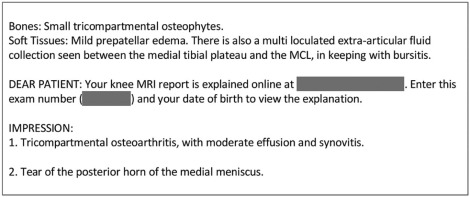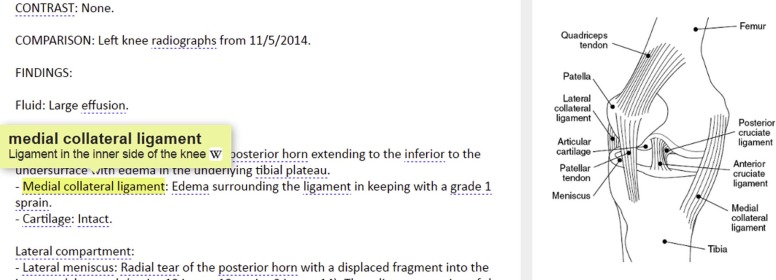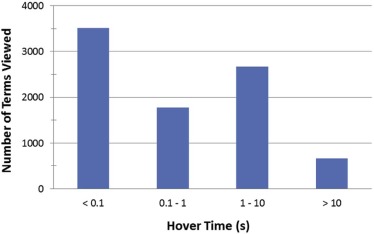Rationale and Objectives
The increasing availability of personal health portals has made it easier for patients to obtain their imaging results online. However, the radiology report typically is designed to communicate findings and recommendations to the referring clinician, and may contain many terms unfamiliar to lay readers. We sought to evaluate a web-based interface that presented reports of knee MRI (magnetic resonance imaging) examinations with annotations that included patient-oriented definitions, anatomic illustrations, and hyperlinks to additional information.
Materials and Methods
During a 7-month observational trial, a statement added to all knee MRI reports invited patients to view their annotated report online. We tracked the number of patients who opened their reports, the terms they hovered over to view definitions, and the time hovering over each term. Patients who accessed their annotated reports were invited to complete a survey.
Results
Of 1138 knee MRI examinations during the trial period, 185 patients (16.3%) opened their report in the viewing portal. Of those, 141 (76%) hovered over at least one term to view its definition, and 121 patients (65%) viewed a mean of 27.5 terms per examination and spent an average of 3.5 minutes viewing those terms. Of the 22 patients who completed the survey, 77% agreed that the definitions helped them understand the report and 91% stated that the illustrations were helpful.
Conclusions
A system that provided definitions and illustrations of the medical and technical terms in radiology reports has potential to improve patients’ understanding of their reports and their diagnoses.
Introduction
The increasing availability of patient portals—personalized access to the electronic health record—has made it easier for patients to access appointment information, medication lists, and test results online . A survey of adult outpatients undergoing imaging within an academic health system revealed that 64% of respondents were interested in receiving an electronic copy of their radiology report in its original form . A cross-sectional study of more than 100,000 patients within a single health system demonstrated that 51% of the patients who had access to their radiology reports viewed their reports online .
Radiology reports historically have been composed to communicate findings to the ordering physician and guide the next steps in a patient’s management . Even though patients now can access their imaging reports, they often find it difficult to interpret the medical jargon contained in these results . In many cases, they also do not fully appreciate the rationale for undergoing an imaging test . Furthermore, the difficulty in understanding reports reviewed online in the absence of a discussion with a physician on the care team may result in miscommunication and unnecessary patient anxiety . To mitigate this anxiety, most patient portals release results after a fixed delay to allow ordering physicians to contact patients directly and discuss abnormal test results before patients can view the results online. A survey of referring physicians did not indicate that they experienced an increased workload as a result of the introduction of patient portals or the implementation of the delay in releasing results to patients .
Get Radiology Tree app to read full this article<
Methods
Get Radiology Tree app to read full this article<
Get Radiology Tree app to read full this article<
Get Radiology Tree app to read full this article<
Get Radiology Tree app to read full this article<
Get Radiology Tree app to read full this article<
Get Radiology Tree app to read full this article<
Get Radiology Tree app to read full this article<
Results
Get Radiology Tree app to read full this article<
Get Radiology Tree app to read full this article<
TABLE 1
Number of Terms Used in Reports and Viewed by the Patients
Number Present in Report Number Viewed Fraction Viewed Unique Terms Total Terms Unique Terms Total Terms Unique Terms (%) Total Terms (%) Minimum 31 44 0 0 0 0 Maximum 72 132 57 464 100 100 Mean 50.0 83.1 16.5 46.7 32 56 Median 50 82 15 23 28 28
Note: If the term “normal” appears four times in a report, for example, that is counted as one unique term and four total terms. The number viewed tallied all terms over which the user hovered to view the definition.
TABLE 2
The 20 Most Commonly Viewed Terms and the Number of Times Viewed
Term No. of Views Normal 406 Cartilage 232 Medial meniscus 179 Medial collateral ligament 175 Signal 159 Posterior horn 142 Full thickness 133 Medial compartment 131 Patella 124 Lateral collateral ligament complex 124 Lateral meniscus 121 Subchondral 114 Edema 110 Anterior cruciate ligament 110 Knee effusion 91 Irregularity 86 Tricompartmental 83 Lateral femoral condyle 81 Popliteal cyst 80 Body 80
Get Radiology Tree app to read full this article<
Get Radiology Tree app to read full this article<
TABLE 3
Survey Questions and Responses
Statement Mean Score Agree (%) The definitions of underlined words helped me understand the report. 4.09 17 (77) Reading my report online was helpful. 4.64 21 (95) I understand better what radiologists do. 3.86 15 (68) The pop-up definitions were distracting. 2.05 3 (14) The pictures and drawings were helpful. 4.27 20 (91) The definitions were easy to read and understand. 4.36 18 (82)
Note: Patients were asked to respond using a 5-point Likert scale ranging from 1 (strongly disagree) to 5 (strongly agree). The table shows the mean score and the number and percentage of patients who responded either 4 or 5 (“Agree”).
Get Radiology Tree app to read full this article<
Discussion
Get Radiology Tree app to read full this article<
Get Radiology Tree app to read full this article<
Get Radiology Tree app to read full this article<
Get Radiology Tree app to read full this article<
Get Radiology Tree app to read full this article<
Get Radiology Tree app to read full this article<
Appendix
Get Radiology Tree app to read full this article<
Get Radiology Tree app to read full this article<
References
1. Ryan B.L., Brown J.B., Terry A., et. al.: Implementing and using a patient portal: a qualitative exploration of patient and provider perspectives on engaging patients. J Innov Health Inform 2016; 23: pp. 848.
2. Irizarry T., DeVito Dabbs A., Curran C.R.: Patient portals and patient engagement: a state of the science review. J Med Internet Res 2015; 17: pp. e148.
3. Peacock S., Reddy A., Leveille S.G., et. al.: Patient portals and personal health information online: perception, access, and use by US adults. J Am Med Inform Assoc 2016; pii: ocw095
4. Arnold C.W., McNamara M., El-Saden S., et. al.: Imaging informatics for consumer health: towards a radiology patient portal. J Am Med Inform Assoc 2013; 20: pp. 1028-1036.
5. Cabarrus M., Naeger D.M., Rybkin A., et. al.: Patients prefer results from the ordering provider and access to their radiology reports. J Am Coll Radiol 2014; 12: pp. 556-562.
6. Miles R.C., Hippe D.S., Elmore J.G., et. al.: Patient access to online radiology reports: frequency and sociodemographic characteristics associated with use. Acad Radiol 2016; 23: pp. 1162-1169.
7. Wallis A., McCoubrie P.: The radiology report–are we getting the message across?. Clin Radiol 2011; 66: pp. 1015-1022.
8. Bruno M.A., Petscavage-Thomas J.M., Mohr M.J., et. al.: The “open letter”: radiologists’ reports in the era of patient web portals. J Am Coll Radiol 2014; 11: pp. 863-867.
9. Rosenkrantz A.B., Flagg E.R.: Survey-based assessment of patients’ understanding of their own imaging examinations. J Am Coll Radiol 2015; 12: pp. 549-555.
10. Smith J.N., Gunderman R.B.: Should we inform patients of radiology results?. Radiology 2010; 255: pp. 317-321.
11. Johnson A.J., Frankel R.M., Williams L.S., et. al.: Patient access to radiology reports: what do physicians think?. J Am Coll Radiol 2010; 7: pp. 281-289.
12. Henshaw D., Okawa G., Ching K., et. al.: Access to radiology reports via an online patient portal: experiences of referring physicians and patients. J Am Coll Radiol 2015; 12: pp. 582-586. e1
13. Mervak B.M., Davenport M.S., Flynt K.A., et. al.: What the patient wants: an analysis of radiology-related inquiries from a web-based patient portal. J Am Coll Radiol 2016; 13: pp. 1311-1318.
14. Oh S.C., Cook T.S., Kahn C.E.: PORTER: a prototype system for patient-oriented radiology reporting. J Digit Imaging 2016; 29: pp. 450-454.
15. Ellenbogen P.H.: Imaging 3.0: what is it?. J Am Coll Radiol 2013; 10: pp. 229.
16. Pahade J., Couto C., Davis R.B., et. al.: Reviewing imaging examination results with a radiologist immediately after study completion: patient preferences and assessment of feasibility in an academic department. AJR Am J Roentgenol 2012; 199: pp. 844-851.
17. Mangano M.D., Rahman A., Choy G., et. al.: Radiologists’ role in the communication of imaging examination results to patients: perceptions and preferences of patients. AJR Am J Roentgenol 2014; 203: pp. 1034-1039.
18. Miller P., Gunderman R., Lightburn J., et. al.: Enhancing patients’ experiences in radiology: through patient-radiologist interaction. Acad Radiol 2013; 20: pp. 778-781.
19. Baorto D.M., Cimino J.J.: An “infobutton” for enabling patients to interpret on-line Pap smear reports. Proc AMIA Symp 2000; pp. 47-50.
20. Cook D.A., Teixeira M.T., Heale B.S., et. al.: Context-sensitive decision support (infobuttons) in electronic health records: a systematic review. J Am Med Inform Assoc 2017; 24: pp. 460-468.
21. Tieu L., Schillinger D., Sarkar U., et. al.: Online patient websites for electronic health record access among vulnerable populations: portals to nowhere?. J Am Med Inform Assoc 2016; pii: ocw098
22. Graetz I., Gordon N., Fung V., et. al.: The digital divide and patient portals: internet access explained differences in patient portal use for secure messaging by age, race, and income. Med Care 2016; 54: pp. 772-779.
23. Hansberry D.R., Agarwal N., Baker S.R.: Health literacy and online educational resources: an opportunity to educate patients. AJR Am J Roentgenol 2015; 204: pp. 111-116.
24. Gunn A.J., Mangano M.D., Choy G., et. al.: Rethinking the role of the radiologist: enhancing visibility through both traditional and nontraditional reporting practices. Radiographics 2015; 35: pp. 416-423.
25. Zeng-Treitler Q., Goryachev S., Kim H., et. al.: Making texts in electronic health records comprehensible to consumers: a prototype translator. AMIA Annu Symp Proc 2007; pp. 846-850.


